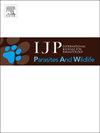厄瓜多尔海岸恰加斯病流行区野生哺乳动物中的克氏锥虫
IF 2.2
3区 医学
Q3 ECOLOGY
International Journal for Parasitology-Parasites and Wildlife
Pub Date : 2025-04-18
DOI:10.1016/j.ijppaw.2025.101073
引用次数: 0
摘要
克氏锥虫是一种引起厄瓜多尔地方病恰加斯病的原生动物寄生虫。在Los Ríos省,存在双口三角瘤病媒,病媒传播被认为是主要感染途径。许多哺乳动物参与克氏锥虫的传播周期。尽管如此,在厄瓜多尔海岸哺乳动物水库方面,特别是在生态改变地区,仍然存在重大差距。为了调查野生和家养哺乳动物作为宿主的作用,我们在克维多州的两个地方评估了克氏锥虫的存在。采样重点是野生、家养和家养哺乳动物,使用现场捕获技术,如对蝙蝠使用雾网,对陆生哺乳动物使用谢尔曼和战斧陷阱。收集所有个体的血液样本,并使用商业试剂盒提取DNA。针对克氏T. crozi基因组的三个区域进行PCR。共采集哺乳动物383只,其中家畜66只,圈养动物6只,野生动物317只。在野生哺乳动物中,216只在拉维吉尼亚2号捕获,95只在雅克姆森林捕获。4只野生个体的克氏体检测呈阳性,包括3只舌蝗和1只猴腹蝗,均采集于近郊社区La Virginia 2。所有家畜和围家畜均未感染。本研究首次报道了西蒙西氏分枝杆菌与克氏锥虫的感染。阳性病例仅在靠近人类住区的地区出现,这引起了人们对过渡景观中寄生虫传播风险的关注。已知寄生虫的传播周期受土地利用变化、森林砍伐和寄主群落组成的影响。这些因素可能改变病媒与宿主之间的生态相互作用,可能有利于传播。厄瓜多尔需要进一步研究,以了解生态系统变化如何影响克氏锥虫的森林循环,特别是蝙蝠在疾病维持中的作用。本文章由计算机程序翻译,如有差异,请以英文原文为准。

Trypanosoma cruzi in wild mammals from an endemic area of Chagas disease on the coast of Ecuador
Trypanosoma cruzi is a protozoan parasite that causes Chagas disease, endemic in Ecuador. In the province of Los Ríos, where the vector Triatoma dimidiata is present, vector-borne transmission is considered the primary route of infection. Many mammalian are involved in the transmission cycle of T. cruzi. Nonetheless, significant gaps remain regarding mammalian reservoirs along the Ecuadorian coast, especially in ecologically altered areas. To investigate the role of wild and domestic mammals as hosts, we assessed the presence of T. cruzi in two localities of Quevedo canton. Sampling focused on wild, domestic, and peridomestic mammals using live capture techniques such as mist nets for bats and Sherman and Tomahawk traps for terrestrial mammals. Blood samples were collected from all individuals, and DNA was extracted using a commercial kit. PCR was performed targeting three regions of the T. cruzi genome. In total, 383 mammals were sampled: 66 domestic animals, 6 peridomestic, and 317 wild individuals. Of the wild mammals, 216 were captured in La Virginia 2 and 95 in the Jacome Forest. Four wild individuals tested positive for T. cruzi, including three Glossophaga soricina and one Marmosa simonsi, all collected from La Virginia 2, a peri-urban community. None of the domestic or peridomestic animals were infected. This study reports, for the first time, the infection of M. simonsi with T. cruzi. The presence of positive cases exclusively in an area close to human settlements raises concern about the risk of parasite transmission in transitional landscapes. Transmission cycles of the parasite are known to be influenced by land-use change, deforestation, and host community composition. These factors may alter ecological interactions between vectors and hosts, potentially favoring transmission. Further research is needed in Ecuador to understand how ecosystem alterations shape the sylvatic cycle of T. cruzi, particularly the role of bats in disease maintenance.
求助全文
通过发布文献求助,成功后即可免费获取论文全文。
去求助
来源期刊

International Journal for Parasitology-Parasites and Wildlife
Medicine-Infectious Diseases
CiteScore
3.80
自引率
5.60%
发文量
113
审稿时长
45 days
期刊介绍:
The International Journal for Parasitology: Parasites and Wildlife (IJP-PAW) publishes the results of original research on parasites of all wildlife, invertebrate and vertebrate. This includes free-ranging, wild populations, as well as captive wildlife, semi-domesticated species (e.g. reindeer) and farmed populations of recently domesticated or wild-captured species (e.g. cultured fishes). Articles on all aspects of wildlife parasitology are welcomed including taxonomy, biodiversity and distribution, ecology and epidemiology, population biology and host-parasite relationships. The impact of parasites on the health and conservation of wildlife is seen as an important area covered by the journal especially the potential role of environmental factors, for example climate. Also important to the journal is ''one health'' and the nature of interactions between wildlife, people and domestic animals, including disease emergence and zoonoses.
 求助内容:
求助内容: 应助结果提醒方式:
应助结果提醒方式:


